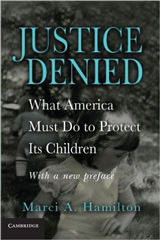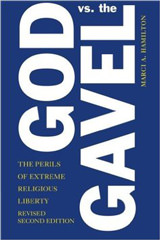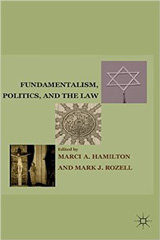Yesterday, January 11, the Supreme Court decided Hosanna-Tabor Evangelical Lutheran Church and School v. EEOC. The unanimous decision was rendered in a matter of months. Unanimity was possible because the Justices had some broad areas of agreement, and because their decision was quite narrow.
The Facts of the Case, and the Legal Question It Raised
The question in the case was whether Cheryl Perich could sue her church-school employer for discrimination under the Americans with Disabilities Act (ADA). Following a leave taken so that she could receive treatment for narcolepsy, Perich tried to return to work, but her employer, Hosanna-Tabor Evangelical Lutheran Church (“Hosanna-Tabor”), fired her.
In defense of its firing, Hosanna-Tabor claimed that Perich was a minister, and that, therefore, it had a First Amendment right to fire her for not following its precepts—one of which, it claimed, was the precept that one should not go to court with employment discrimination claims like Perich’s.
Perich contended, in response, that she was not a minister, just a teacher, and argued that Hosanna Tabor had violated her federal statutory rights against disability discrimination.
Most of Perich’s duties and teaching subjects were secular, but she was a “called” teacher with some religious responsibilities. The U.S. Court of Appeals for the Sixth Circuit held that, functionally, she was a secular teacher with few religious obligations and, therefore, that she was not a minister. It thus concluded that Hosanna-Tabor had no First Amendment defense, and that Perich could invoke federal antidiscrimination law in the suit regarding her firing.
The Supreme Court’s Ruling: Perich Was a Minister
The Supreme Court, however, rejected the Sixth Circuit’s analysis and concluded that Perich was a minister.
At the oral argument, there was one persistent question that became the argument’s theme: Can the government force the Catholic Church to include women in the priesthood, or compel Orthodox Jews to include women in the rabbinate? There seemed to be universal agreement among the Justices and the litigants that the First Amendment certainly forbids that kind of compulsion.
Perich and the EEOC had tried to argue that the First Amendment right of association would separately protect such decisions, so that the ministerial exception need not apply. The Court, however, found “this position untenable”—explaining that “we cannot accept the remarkable view that the religion Clauses have nothing to say about a religious organization’s freedom to select its own ministers.”
Thus, the case proved to be solely about clergy (ordained or not), and the issue was whether Hosanna-Tabor was bound by federal antidiscrimination law with respect to its clergy—including Perich, as she was a “called” teacher. The Court held that a religious organization has a First Amendment-based affirmative defense to discrimination claims by clergy. And, the Court made clear that it meant not only disability discrimination claims, but other discrimination claims as well.
As the Decision Is Narrow, Doctrine in This Area Will Need to Be Developed Further
The upshot is that religious organizations can fire clergy based on disability, race, or gender, and clergy will not be able to sue them for invidious discrimination. No one becomes clergy in the United States expecting to face such discrimination, but now at least those who are being ordained can know from the start that if they are ever subject to invidious discrimination by their religious institution, they will have no legal recourse.
The decision is quite narrow, however. Religious organizations—primarily the Roman Catholic Church and the Church of Jesus Christ of Latter-Day Saints—have argued for at least a decade in the courts that the First Amendment grants them “autonomy” from the law. Part of their theory has been that courts do not even have jurisdiction to accept cases in which employees sue religious organizations. However, the Supreme Court straightforwardly rejected that jurisdictional theory.
Instead, the Court ruled as follows: “District courts have power to consider ADA [Americans with Disabilities Act] claims in cases of this sort, and to decide whether the claim can proceed or is instead barred by the ministerial exception.”
Thus, if an employee is not a minister, the religious organization at issue will still have to deal with the ADA, and Title VII, the main federal race and gender-discrimination statute. Cases will turn on the facts concerning whether the employee-plaintiff is a minister.
The “Parade of Horribles” the Court Declined to Address
The Court also acknowledged the “parade of horribles” that the EEOC and Perich predicted would follow if they sided with Hosanna-Tabor. However, it also pointed out that its decision did not reach or resolve other legal disputes.
The Court’s opinion states, “According to the EEOC and Perich, such an exception could protect religious organizations from liability for retaliating against employees for reporting criminal misconduct or for testifying before a grand jury or in a criminal trial.” But the Court noted that even Hosanna-Tabor has not gone that far: “Hosanna-Tabor responds that the ministerial exception would not in any way bar criminal prosecutions for interfering with law enforcement investigations or other proceedings. Nor, according to the Church, would the exception bar government enforcement of general laws restricting eligibility for employment, because the exceptions applies only to suits by or on behalf of ministers themselves.”
Thus, the Court concludes, “The case before us is an employment discrimination suit brought on behalf of a minister, challenging her church’s decision to fire her. Today we hold only that the ministerial exception bars such a suit. We express no view on whether the exception bars other types of suits, including actions by employees alleging breach of contract or tortious conduct by their religious employers.”
The Court’s Bottom Line: Courts Cannot Establish Selection Criteria for Clergy
The Court therefore distinguished other potential legal disputes between clergy and religious organizations. The ministerial exception, it made clear, does not involve employees other than clergy, and may well not implicate a large range of legal disputes brought by clergy, e.g., a dispute over whether the religious organization paid the full salary and benefits expected in the employment contract. Standing even farther afield, and not mentioned by the Court, are cases that involve clergy or religious organizations, but that are brought by third parties, such as child-sex-abuse victims.
The bottom line is that the government may not establish selection criteria for clergy. Religious organizations are free, under the First Amendment, to discriminate by sex, disability, or race. And they can fire a minister at will, without having to worry about the federal anti-discrimination laws. But the Court did not hold—or even approach the notion—that religious organizations operate autonomously with respect to any body of law other than the federal anti-discrimination laws.










Wow, they’ll be a mass exodus of teachers from religious schools when they realize that federal/state employee protection laws no longer apply to them.
A partial list of protections not afforded to “ministerial employees” in religious organization include: The Fair Labor Standards Act (FLSA), Occupational Safety and Health Act (OSHA) , Workers Compensation Act, Employee Benefit Security (ERISA), Family and Medical Leave Act (FMLA), Equal Opportunity Employment Act (EEOC), Americans with Disabilities Act (ADA), Veterans Preference Act (VPA), not to mention other state protection laws.
Who but the dregs of the employment pool would work as a teacher in a
religious school, unless either for purely missionary purposes or with
independent wealth?
[…] The Supreme Court Embraces a Narrow Ministerial Exception to Federal Anti-Discrimination Laws. Read more […]
A small tax for the protection they enjoy would be fair and acceptable at this point?
[…] short, the question was whether: Cheryl Perich could sue her church-school employer for discrimination under the Americans […]
[…] U.S. Supreme Court’s pro-discrimination decision in Hosanna-Tabor Church v. EEOC finally brings U.S. law in line with the millennia-old opinion of Yahweh regarding the hiring and […]
Thank you Marci, for expert detailed explanation..!
[…] new decision by the United State Supreme Court that invites blatant discrimination by churches, Hosanna-Tabor Church v. EEOC. The above post by Michael Morris squarely fits the formula announced by […]
[…] it make it harder to prosecute priests simply because the church is above being held accountable? Marci Hamilton, a professor at Cardozo School of Law at Yeshiva University, “The upshot is that religious organizations can fire clergy based on disability, race, or […]